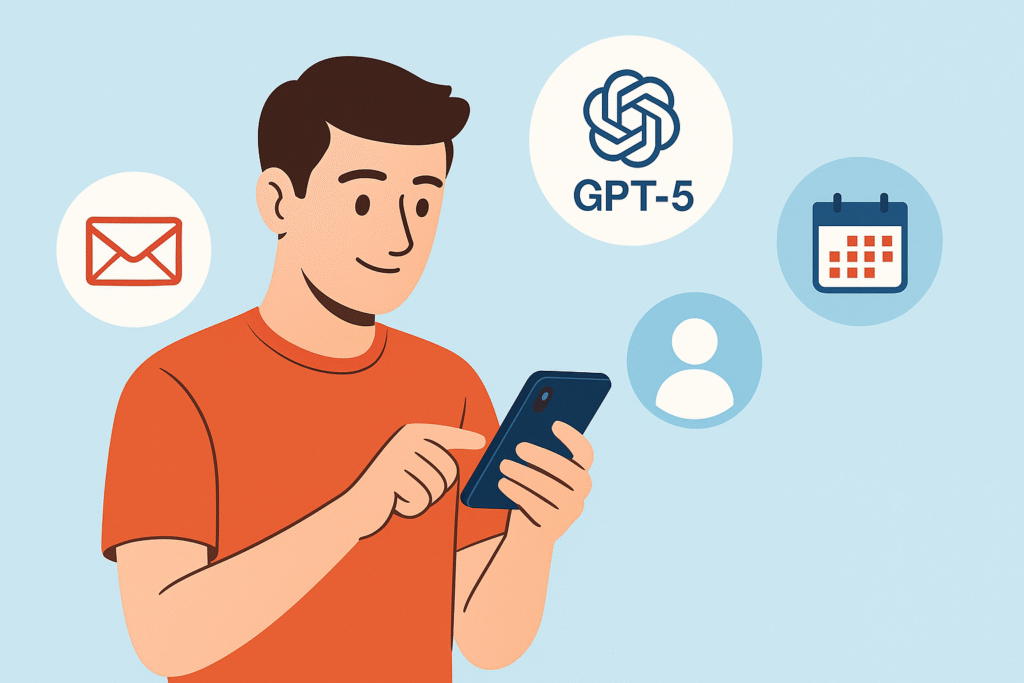With a dash of worry, the most recent ChatGPT transformation felt more like magic than technology.

ChatGPT’s Transformation into Much More Than Just a Chatbot
As I logged into ChatGPT with a freshly brewed cup of coffee, I noticed a blinking notice indicating that it could now access my Gmail, Google Calendar, and Contacts. I can still clearly recall that morning. With my heart pounding, I sat there. Strangely, it felt somewhat comforting as well as like voluntarily letting someone into my virtual brain.
As I dug deeper, I discovered that these features were official and not just rumors. According to TechRadar, OpenAI had launched a “Connectors” system that allowed access only with my consent (yes, they emphasized that you had to opt in!) for tasks like scheduling and email summarization, all while remaining in the chat window.
Experimenting with the “Auto,” “Fast,” and “Thinking” chat modes
Next came the new GPT-5 modes that became available:
- Automating the trade-off between speed and deep reasoning is possible with auto mode.
- In situations where I need a quick fix, fast is for lightning answers.
- In the thinking mode? That’s the brainiac, which has an absurd context limit of 196,000 tokens and is made for in-depth discussions and challenging tasks. Before descending to “Thinking Mini,” GPT-5 Plus users like me receive 3,000 messages every week in Thinking mode (News9live).
I tried thinking instead of switching. ChatGPT felt like my thesis advisor all of a sudden, and it wasn’t an hourly fee.
Witnessing the Development of My Day
“What’s on my plate today?” I typed shortly after.-and ChatGPT quickly summarized my day by scanning my calendar, retrieving unread emails, and synthesizing the information. For an old thread that I had forgotten about, it even recommended sending a follow.
With the exception of needing to rub a lamp, it felt entirely like Aladdin’s genie.
A Combination of Caution and Buzz
Let me be honest, though: this isn’t all sunshine and roses. Given that ChatGPT is aware of specifics like my scheduled workout for tomorrow or that confidential therapy session for next week… It made me feel vulnerable. Yes, OpenAI guarantees that users must confirm any emails before sending them and grant access.
Even so, I couldn’t get rid of the realization that I was sacrificing privacy in favor of convenience. And that is a significant consideration in a society where trust must be earned.
The Big Picture: Going Beyond Gmail
In his livestream of the August 7, 2025, launch of GPT-5, Sam Altman portrayed it as a step toward comprehension and reactivity—less hallucinations, more complex conversation, and even emotional intelligence (TechRadar).
GPT-5 removed the model picker for many users and now automatically alternates between base, Thinking, mini, and nano variants according to subscription level and necessity.
How Do I Feel Right Now?
- Exceptionally productive? Absolutely. Having my emails, schedule, and contacts in one chat has literally cut my tab-switching in half.
- Feeling a little cautious? Indeed. I am aware that a tech company now has access to my private information in a manner that software did not previously have.
- Wondering? Quite. I’m interested to see how long it will take for this type of AI to become standard in daily operations.
Ultimately, as I sit and think with my digital assistant turned confidant, I’m caught between admiring how easy my day has become and wondering if the cost of that convenience is a little higher than I initially thought.
Disclaimer:
This article has been written and fact-checked using information from reliable and verified sources. The accompanying images are AI-generated and are intended for illustrative purposes only; they do not depict real individuals or events.